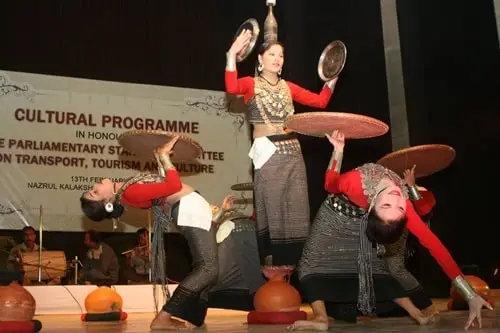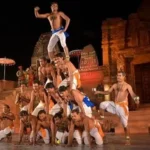The vibrant culture of Tripura is not only found in the religious and traditional activities, but also in the artistic expressions. There a 6 kind of dance forms in Tripura that are mainly popular. Diverse and extremely expressive in their rhythms and vibes, these dance forms have captured the imagination of thousands. Here we talk about these different dance forms.
The Reang Dance

One of Tripura’s most beautiful dances is Reang, or Hojagiri. Tripura’s highlands Reang culture embraces this fascinating dance style. Festivals and other events showcase Hojagiri’s beauty and significance. Hojagiri women do this lovely dance. They dance to bamboo flute and drum beats with precision and elegance while balancing clay pots on their heads. Synchronized dancers and instruments captivate spectators. Hojagiri is more than entertainment for Reangs. This dance celebrates women, tradition, and community. Reang women’ graceful pot-balancing shows their strength and skill. They persevere by carrying the pots and their culture.
The Hozagiri Dance
The energetic Tripura Chakma devised the Hozagiri dance. Known for their rich history and art, the Chakma created this mesmerizing dance. Hozagiri is beautiful and distinctive martial arts and performance. Men demonstrate their boldness and skill in the Hozagiri dance. Swords on performers’ heads identify this dance. This alone requires precision and control. Acrobatic dancers need speed and balance. Chakma men’s sword balance, twirling, and jumping are amazing. Dynamic and daring choreography make the dance stunning. Each move shows the artists’ athleticism and bravery, dazzling audiences. Beyond his athleticism, Hozagiri is essential to Chakma culture. It describes their people’s struggles and accomplishments. The Chakma dance commemorates their ancestors and traditions.
The Lebang Boomani Dance
The Tripuri and Jamatia tribes of Tripura have kept their culture and dancing forms. These artifacts include the Tripuri dance Lebang Boomani, which celebrates their heritage. This interesting dance is enthusiastically performed at religious ceremonies. The rhythmic and energetic motions of Lebang Boomani depict Tripuri culture. Dancers communicate their people’s story using circular patterns and intricate footwork. Indigenous clothing and jewelry make the dance a colorful and artistic spectacle. Tripuri flutes and drums like the Sumui and Chongpreng enhance the dance’s charm. The flute and drum beats accompanying the dancers transport participants and bystanders.
The Goria Dance
Goria dance is essential to Tripura’s Native culture. At the Jamatia tribe’s Goria celebration, which marks the New Year, this vibrant dance is particularly noticeable. The Goria dance gratefully thanks the goddesses for the great harvest and fortune. In the Goria dance, men and women form a circle and grasp hands, swaying to drums and cymbals. The vibrant colors of their traditional clothes and sparkling jewelry make this synchronized dance breathtaking. Beyond its beauty, the Goria dance represents Jamatia peace and unity. They dance together, emulating nature and agriculture, to show their connection to the land that feeds them. Unity and togetherness are vital for cultural preservation and community identity.
The Wangala Dance
Tripura’s Garo culture includes the Wangala dance. This lovely dance shines during Wangala, a cheerful and meaningful occasion. The dance thanks Misi Saljong, the sun goddess, for a bountiful harvest. Men in Wangala dance wear feathered turbans to enhance their performance. These dancers play the Dama bamboo flute, adding melody. Female artists add visual appeal with vibrant outfits and jewelry. Every Wangala step is synchronized and rhythmic. As the dance evolves, the Garo community celebrates and strengthens their culture. It demonstrates their cultural resilience and common values. The Wangala dance shows Garo love of nature and agriculture. At Wangala, the community appreciates and celebrates Misi Saljong’s generosity. Garo people continue the Wangala dance to represent their culture and community. It stresses gratitude, togetherness, and celebration in a changing world and the need to preserve cultural resources for future generations.
The Moniarka Dance
Tripura Tripuri dance Moniarka. This fascinating dance is part of many traditional occasions, notably Kharchi Puja, the state’s most popular religious holiday. Male Moniarka dancers use headdresses and Tripuri. Female dancers sparkle in bright clothes and jewelry. Tripuri mythology and culture are conveyed via the dance’s precise footwork and elegant motions The relevance of Moniarka transcends art. Future generations learn Tripuri culture. Dancers delicately reflect their community’s centuries-old customs. Moniarka represents Tripuri persistence in preserving their traditions. Tripuri festivals and celebrations use this dance to preserve their values, beliefs, and tales. Sharing their unique culture inspires and educates future generations.
Conclusion
The traditional dances of Tripura are a testament to the cultural diversity and rich heritage of the state. These dances not only entertain but also serve as a means of preserving and transmitting the unique traditions and stories of the indigenous communities. As Tripura continues to embrace modernity, it is essential to recognize and celebrate these traditional dance forms, ensuring that they remain a vibrant part of the state’s cultural fabric for generations to come. The enchanting rhythms of Tripura’s traditional dances are a source of pride and a window into the soul of this beautiful state in northeastern India.
Santosh Kumar, the author behind IndiasStuffs.com, is passionate about sharing valuable insights on a variety of topics, including lifestyle, technology, and Indian culture.
Page Contents

